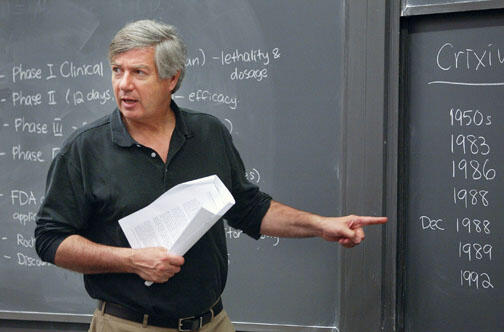When new technologies pose public-policy dilemmas
A deadly flu outbreak in Asia is fueling fears of a global pandemic. You head the company that makes the world’s most popular flu drug, and as nations scramble to stockpile your product, you face an important choice: Should you rapidly increase production, at great cost, and risk being saddled with a surplus of drugs that have a limited shelf life? Or should you follow a slower growth trajectory, increasing the probability that some countries might grant competitors emergency licenses to produce your patented drug?
In November, students in the engineering course “Technical Innovation and Foreign Policy,” taught by visiting lecturer James Shinn ’73 *01, dissected this dilemma in a case study of Roche, maker of the drug Tamiflu, during the 2004–05 avian flu scare.
The team of students that started the discussion filled the blackboard with a tree of equations that represented different scenarios, with two main branches showing a crash course of increased production and a more conservative path of steady growth. After crunching the numbers, the students concluded that steady growth was more profitable, given the relatively low probability of a pandemic. But the discussion was just beginning.
Steady growth may be Roche’s preferred route, but what is best for the public? How might governments alter the incentive structure? Could an influx of competing antiviral drugs reshape the discussion? And what public-health measures might reduce the need for stockpiling Tamiflu? For more than an hour, students explored these questions and others.
Shinn, a former assistant secretary of defense in President George W. Bush’s administration and a veteran of several high-tech startups, said that his course’s true-to-life case studies aim to re-create two parallel rooms: the office of a government agency and a company’s executive suite.
“Both the government entity and the private entity have a set of decisions, and their desired endpoints may be different,” Shinn said. “It adds a reality of decision-making that often doesn’t emerge through either the standard public-policy course or the standard technology course.”
Shinn first taught at Princeton in 2002, shortly before joining the CIA as the national intelligence officer for East Asia. In discussions of some case studies, he is prevented from talking about specific experiences from his days in Washington. But that doesn’t stop his students from placing themselves in the shoes of policymakers and technology executives.
Using the case method to explore tech topics may bring to mind Ed Zschau ’61’s popular course, “High-Tech Entrepreneurship,” which Shinn jokingly calls the “secret twin” of his class. Jonathan Mayer ’09, a Woodrow Wilson School graduate and computer scientist who took both courses last year, said that the classes complement each other: Zschau’s delves into the business operations of a technology startup, while Shinn’s tends to focus on larger, more strategic issues. “It’s almost like micro- and macroeconomics,” Mayer said.
Both courses are part of the Keller Center for Innovation in Engineering Education’s effort to engage a wider audience in engineering courses. A majority of Shinn’s students have been science or engineering majors, but the class also has included students who concentrate in German, history, philosophy, and economics. Today’s undergraduates, Shinn said, have a strong and “often underutilized” background in science and technology.
At the end of the Tamiflu discussion, the consensus opinion opposed adopting extreme measures to increase production of the drug, either by Roche or its competitors. But solutions rarely are cut and dried, according to students in the class.













No responses yet